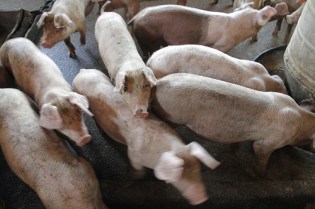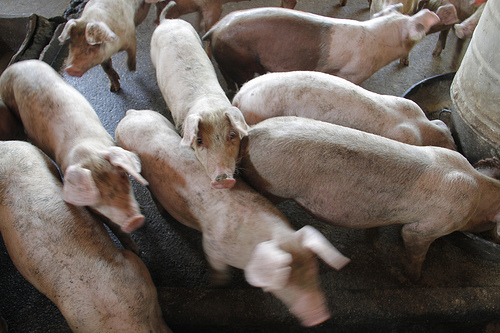
Photo by Edmund Yeo.
On Wednesday, thanks to a collaboration with a new nonprofit news organization called the Food and Environment Reporting Network, MSNBC ran an in-depth report on ractopamine hydrochloride, a drug commonly used in pigs and known on the market as Paylean.
The story is important for two reasons. First, it has the potential to widen the public’s understanding of a powerful, overused drug, and to help us dig down into what it really means when we hear about the use of growth-promoting drugs in meat. Second, it’s the mark of a new voice in food journalism — one that’s well worth paying attention to if you’re interested the intersection of food and the environment.
Lean pigs, creepy residue?
Why do livestock producers use ractopamine? Because it “promotes leanness” in pigs. According to the article’s author, Helena Bottemiller, when they are fed the drug in the finishing stage of their life span, pigs produce “an average of 10 percent more meat [versus fat], compared with animals on the same amount of feed that don’t receive the drug. That raises profits by $2 per head.”
On the consumer end, however, traces of the drug have been found in pork. But just how much and how often is up for debate –- in part because the FDA’s budget to test this kind of thing is severely limited. In a related post on the Food and Environment Reporting Network’s website, Bottemiller writes:
Though ractopamine is widely used in pigs and cattle, testing for the residues in food animals is limited.
Last year, for example, no tests were conducted on 22 billion pounds of pork produced in the United States; 712 samples were taken from 26 billion pounds of beef but the results have not yet been released. [Emphasis mine.]
In the article, Bottemiller details the drug’s impact and the current tussle over its role in international pork trade. (The short version: China, the European Union, Taiwan, and other nations have all outlawed the drug. Currently there isn’t even a Proposed Maximum Residue Limit for ractopamine, and the global food standards-setting entity that decided just how much of the stuff is safe is stuck in a complex political gridlock.)
According to the article, ractopamine is “fed to an estimated 60 to 80 percent of pigs in the United States” and has “sickened or killed more than 218,000 pigs as of March 2011” (more than any other drug fed to animals). It’s also often linked to instances of downer pigs, or those who cannot walk themselves to slaughter.
And — perhaps not surprisingly — when the Food and Drug Administration approved this drug for pigs in 1999, they based the decision on trials conducted by the drugmaker Elanco Animal Health (a division of Eli Lilly and Company).
A new platform for serious food stories
If the folks behind the Food and Environment Reporting Network (a group that includes Grist’s own regular contributor Tom Laskawy, who is the organization’s executive director; Paula Crossfield, managing editor at Civil Eats; and long-time journalist and Organic Inc. author Sam Fromartz) have their way, this article is just the tip of the iceberg for hard-hitting, investigative food stories in the mainstream media.
As editor-in-chief, Fromartz says he has seen many publications limit food coverage to “material that’s very chef- and recipe-focused.” So, he says, the network was born out of a twofold desire. “We were seeing more people interested in food and food policy issues. At the same time, we’ve been witnessing the decline of media over the past few years — journalists being cut, media companies cutting back their in-depth reporting, etc.” Fromartz and his fellow founders knew many writers who’d become steeped in the world of food as it applies to issues like health, food safety, climate change, and labor who, he says, “didn’t have the support to do in-depth work.”
The network pays reporters to take on lengthy investigations that involve travel, heavy research, and multiple interviews in an effort to go beyond today’s blog-centric news coverage. And to get the final products placed in outlets where they will reach a large number of readers — both in print and on the web.
Luckily, the Food and Environment Reporting Network was not without similar models to work from. “There are a lot of precedents,” says Fromartz. “ProPublica is the most noteworthy, but the Center for Investigative Reporting and their project California Watch are also important models. What we have to prove is that there’s a need for it in our particular silo.”
Wednesday’s story was actually the second story funded by the network. The first, entitled “Milk and Water Don’t Mix,” by Stephanie Paige Ogburn, appeared in High Country News last November. For that piece, which details a citizen fight to put pollution from mega-dairies in New Mexico in check, the network funded Ogburn’s travel to New Mexico, where she met with dairy men and environmental activists.
Although the stories published so far are critical of the meat and dairy industries, Fromartz stresses that the network in not an advocacy organization.
“I’ve spent years in really traditional journalistic environments, so I know what those values are,” he says. And while the network isn’t ruling out publishing writing with a clear point of view, it will be that of the writer, not the organizers — nor the editorial board, which includes food editor and writer Ruth Reichl and Newsweek/The Daily Beast’s Katrina Heron).
“I would like ideally to represent the voice of the writers we’re commissioning these stories form,” he says. “We’re not pushing a party line.”




